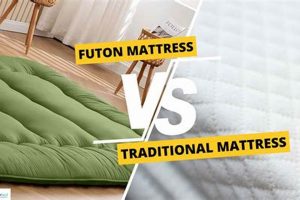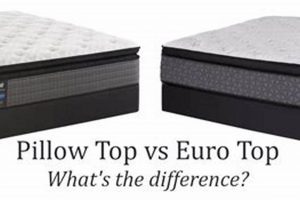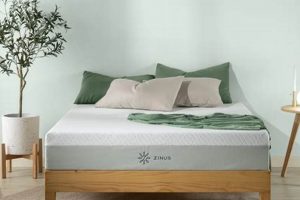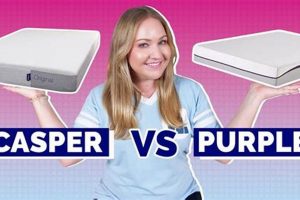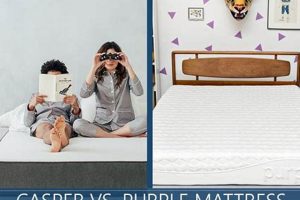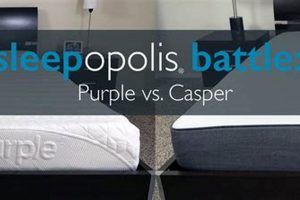The selection of a mattress often hinges on the internal construction, broadly categorized into foam and pocket spring designs. Foam mattresses utilize various densities and compositions of foam, such as memory foam or latex, to provide support and contouring. Pocket spring mattresses, conversely, incorporate individually wrapped coils that react independently to pressure, aiming to minimize motion transfer. This fundamental difference in construction dictates the overall feel and performance characteristics of each mattress type.
Choosing between these two options involves considering individual sleep preferences and needs. Foam structures excel at pressure relief and conforming to the body, potentially alleviating aches and pains. Historically, foam mattresses have evolved from basic polyurethane foams to advanced materials designed for enhanced breathability and durability. Pocket spring systems, on the other hand, offer robust support and often promote better air circulation, contributing to a cooler sleep experience. The development of pocket spring technology has focused on refining coil design and arrangement to optimize support and reduce motion disturbance.
The following sections will delve into a detailed comparison of these mattress types, examining their specific advantages and disadvantages in terms of support, comfort, durability, and suitability for different sleep styles. Analysis will be provided concerning factors like heat retention, motion isolation, and edge support to aid in making an informed decision.
Selecting the appropriate mattress involves a thorough evaluation of individual sleep needs and preferences. The following tips offer guidance when weighing the merits of foam and pocket spring mattress constructions.
Tip 1: Assess Individual Sleep Style: Individuals who sleep predominantly on their side may benefit from the conforming properties of foam, which can alleviate pressure on hips and shoulders. Back or stomach sleepers may find the firmer support offered by pocket springs more suitable for maintaining spinal alignment.
Tip 2: Consider Body Weight: Heavier individuals often require greater support to prevent excessive sinkage. Pocket spring systems, particularly those with higher coil counts and thicker gauge wires, generally provide more robust support for individuals with higher body weight.
Tip 3: Evaluate Heat Retention: Foam mattresses, particularly those constructed with memory foam, can retain heat. Individuals prone to overheating during sleep may wish to consider open-cell foam or pocket spring designs that promote greater airflow.
Tip 4: Examine Motion Isolation Needs: Pocket spring mattresses featuring individually wrapped coils excel at isolating motion, minimizing disturbance from a sleeping partner. Foam mattresses, particularly those with high-density foams, also provide good motion isolation.
Tip 5: Inspect Edge Support Quality: Strong edge support is essential for maximizing the usable sleep surface and facilitating ease of getting in and out of bed. Pocket spring mattresses often incorporate reinforced edges, while foam mattresses may utilize denser foam around the perimeter to enhance edge support.
Tip 6: Analyze Durability Expectations: High-quality foam and pocket spring mattresses can provide years of comfortable sleep. However, the longevity of each type depends on the materials used and the construction techniques employed. Researching reputable brands and reading reviews can offer insights into expected durability.
Tip 7: Investigate Certifications and Warranties: Look for mattresses certified by independent organizations, indicating compliance with safety and performance standards. Review the warranty terms carefully to understand the manufacturer’s commitment to product quality and address any potential defects.
By carefully considering these factors, informed decisions can be made regarding the suitability of foam versus pocket spring mattresses, leading to improved sleep quality and overall well-being.
The subsequent sections will delve deeper into specific aspects, ultimately providing a holistic understanding to aid in the final purchasing decision.
1. Support and Alignment
Proper spinal alignment is paramount for restorative sleep and minimizing musculoskeletal discomfort. The ability of a mattress to provide adequate support and maintain correct posture is a critical differentiator between foam and pocket spring constructions. The choice impacts long-term spinal health and overall sleep quality.
- Contouring and Pressure Relief (Foam Mattresses)
Foam mattresses, particularly those incorporating memory foam, excel at conforming to the body’s contours. This conforming ability distributes weight evenly, reducing pressure points and promoting spinal alignment, especially for side sleepers. However, inadequate density or support within the foam core can lead to excessive sinking, misaligning the spine and causing discomfort. The type of foam and its density significantly determine its efficacy in providing adequate support.
- Independent Coil Response (Pocket Spring Mattresses)
Pocket spring mattresses feature individually wrapped coils that react independently to applied pressure. This independent response allows for targeted support, contouring to the body’s shape and maintaining spinal alignment. The gauge and arrangement of the coils are critical factors. Higher gauge coils offer firmer support, while strategic zoning within the mattress can provide enhanced support to specific areas like the lumbar region.
- Support Core Stability
Regardless of the surface comfort layers, both foam and pocket spring mattresses require a stable support core. In foam mattresses, this often takes the form of a high-density foam base that prevents excessive compression and maintains overall shape. Pocket spring mattresses rely on a sturdy foundation, often consisting of a border wire or reinforced edge, to ensure even weight distribution and prevent sagging. Without a robust support core, both types of mattresses can compromise spinal alignment over time.
- Suitability for Different Sleep Positions
The ideal level of support and alignment differs depending on the sleeper’s preferred position. Side sleepers typically require more contouring to accommodate the curves of the body, making softer foam options potentially suitable. Back sleepers generally benefit from firmer support to maintain the natural curvature of the spine, often finding satisfaction with a pocket spring mattress or a firmer foam option. Stomach sleepers require the firmest support to prevent excessive sinking of the midsection, which can lead to lower back pain. Selecting a mattress that aligns with the individual’s sleep position is essential for promoting healthy spinal alignment.
In summation, both foam and pocket spring mattresses can provide adequate support and alignment, but their effectiveness depends on the specific materials used, the construction techniques employed, and the individual’s sleep preferences and body type. A thorough understanding of these factors is essential for selecting a mattress that promotes optimal spinal health and restorative sleep. The interaction between materials and construction dictates whether spinal alignment is achieved.
2. Motion Isolation
Motion isolation, the ability of a mattress to minimize the transfer of movement across its surface, represents a significant factor in sleep quality, particularly for individuals sharing a bed. The internal construction of a mattress directly influences its capacity for motion isolation; therefore, distinctions between foam and pocket spring designs are crucial. Foam mattresses, owing to their inherent material properties, generally exhibit superior motion isolation compared to traditional innerspring mattresses. The interconnected structure of foam absorbs and dissipates movement, reducing the likelihood of disturbance to a sleeping partner. Pocket spring mattresses, however, represent an advancement over traditional innerspring systems in this regard. The individually encased coils in a pocket spring mattress allow each spring to react independently to pressure, minimizing the spread of movement across the mattress surface. The degree of motion isolation achieved depends on factors such as coil gauge, coil density, and the presence of additional comfort layers like memory foam.
In practical terms, improved motion isolation translates to fewer sleep disruptions caused by a partner’s tossing, turning, or getting in and out of bed. For instance, a light sleeper sharing a bed with someone who frequently changes position during the night would likely benefit from a mattress with enhanced motion isolation capabilities. Examples extend beyond couples; individuals with pets who sleep on the bed may also appreciate a mattress that minimizes the sensation of their pet’s movements. The effectiveness of motion isolation can be quantified through laboratory testing using accelerometers to measure the transmission of vibrations across the mattress surface. These tests provide objective data to compare the performance of different mattress types. Furthermore, online mattress reviews often include subjective feedback from consumers regarding their experiences with motion isolation.
In conclusion, motion isolation constitutes a key consideration when evaluating mattresses. While both foam and pocket spring designs offer varying degrees of motion isolation, the specific construction and materials employed determine their effectiveness. Choosing a mattress with adequate motion isolation can significantly improve sleep quality by reducing disturbances and promoting uninterrupted rest. Ultimately, assessing individual needs and preferences, alongside understanding the performance characteristics of different mattress types, allows for an informed purchasing decision that prioritizes undisturbed sleep.
3. Temperature Regulation
Temperature regulation within a mattress directly impacts sleep comfort and quality. A mattress’s ability to dissipate heat and maintain a neutral sleeping temperature is a key factor in selecting between foam and pocket spring constructions. Insufficient temperature regulation can lead to overheating, restlessness, and disrupted sleep cycles.
- Foam Density and Airflow
Foam mattresses, particularly those composed of high-density memory foam, often exhibit limited airflow. The close-celled structure of dense foam traps heat, potentially causing the sleeper to overheat. Open-cell foam formulations and the inclusion of ventilation channels within the foam core can mitigate this issue, improving breathability and heat dissipation. The density of the foam is a primary determinant of its thermal properties.
- Pocket Spring Design and Ventilation
Pocket spring mattresses inherently offer greater airflow due to the open spaces between the individual coils. This design facilitates the circulation of air, allowing heat to escape and preventing the build-up of moisture. The use of breathable cover materials further enhances ventilation, contributing to a cooler sleep environment. The pocket spring system is conducive to temperature regulation.
- Material Composition of Comfort Layers
The materials used in the comfort layers of both foam and pocket spring mattresses significantly affect temperature regulation. Natural materials, such as latex and cotton, tend to be more breathable than synthetic materials like polyester. Phase-change materials (PCMs), which absorb and release heat to maintain a stable temperature, are sometimes incorporated into mattress covers to enhance thermal comfort. The choice of materials impacts the overall temperature profile of the mattress.
- Environmental Factors and Personal Physiology
External factors, such as ambient room temperature and humidity levels, influence the effectiveness of a mattress’s temperature regulation capabilities. Additionally, individual physiological characteristics, such as metabolic rate and perspiration levels, play a role in determining sleep temperature preferences. What feels cool to one individual may feel warm to another, highlighting the subjective nature of thermal comfort. Environmental conditions interact with mattress properties.
The interplay of material composition, mattress design, environmental factors, and personal physiology determines the overall effectiveness of temperature regulation in both foam and pocket spring mattresses. Understanding these facets is essential for selecting a mattress that promotes a comfortable and restful sleep experience. Ultimately, the ideal choice depends on individual preferences and sensitivities to temperature variations during sleep. Careful evaluation allows for optimized sleep outcomes.
4. Durability and Lifespan
The durability and lifespan of a mattress are critical considerations when evaluating foam mattress vs pocket spring options, representing a direct impact on long-term value. Material quality and construction methods are primary determinants of longevity. Lower-density foams and less robust coil systems tend to degrade more rapidly, resulting in reduced support and comfort over time. Conversely, high-density foams, reinforced edges, and higher-gauge steel coils contribute to increased durability. For example, a memory foam mattress utilizing low-density foam may exhibit significant sagging and body impressions within a few years, whereas a latex mattress with a dense core can maintain its integrity for a decade or more. Similarly, a pocket spring mattress with thinner coils and minimal edge support may experience coil fatigue and perimeter breakdown sooner than a model with thicker coils and reinforced edges. Understanding these material properties is crucial for estimating the long-term cost-effectiveness of each mattress type.
The correlation between usage patterns and mattress lifespan is also significant. Mattresses subjected to higher weights or more frequent use will generally degrade more quickly than those used infrequently or by lighter individuals. Proper maintenance, such as regular rotation, can help to distribute wear and tear more evenly, extending the lifespan of the mattress. Furthermore, the type of foundation upon which the mattress rests can influence its durability. An unsupportive or uneven foundation can place undue stress on the mattress, leading to premature degradation. In practical terms, a family with multiple children using a single mattress may expect a shorter lifespan compared to a single adult using a mattress in a guest bedroom. Mattress protectors also play a crucial role in protecting the mattress from spills, stains, and allergens, all of which can compromise its integrity over time.
In summary, durability and lifespan are paramount when comparing foam mattress vs pocket spring options. Material quality, construction techniques, usage patterns, and maintenance practices all contribute to the overall longevity of the product. While the initial cost of a mattress is a factor, considering the expected lifespan and long-term performance is essential for making an informed purchasing decision. A more durable mattress, though potentially more expensive upfront, can offer superior value over time by providing consistent support and comfort for an extended period, ultimately offsetting the initial investment. The challenge lies in accurately assessing material quality and construction, which often requires thorough research and evaluation of product specifications.
5. Cost Considerations
The economic implications of choosing between foam mattress vs pocket spring constructions represent a significant factor in purchasing decisions. The initial price points of these mattresses can vary substantially, influenced by material quality, manufacturing complexity, and brand reputation. Foam mattresses, particularly those utilizing advanced memory foam or latex formulations, may command a higher upfront cost due to the specialized materials and manufacturing processes involved. Pocket spring mattresses, while often perceived as a more traditional option, can also exhibit a wide range of prices depending on coil count, coil gauge, and the presence of additional comfort layers. For example, a basic innerspring mattress with a thin comfort layer may be significantly cheaper than a high-end memory foam mattress, but it may also offer inferior support and durability. Conversely, a luxury pocket spring mattress with individually wrapped coils, zoned support, and a premium pillow top can rival the price of a high-end foam mattress. Therefore, the initial cost comparison is a complex equation, influenced by numerous variables.
Beyond the initial purchase price, long-term cost considerations must also be taken into account. The lifespan of a mattress is a key factor in determining its overall value. As previously discussed, higher-quality materials and construction techniques generally lead to increased durability and longevity. A less expensive mattress that degrades quickly may ultimately prove more costly than a more durable option, as it will require more frequent replacement. Furthermore, the potential health benefits associated with a higher-quality mattress can translate into cost savings over time. A mattress that provides adequate support and promotes proper spinal alignment may reduce the risk of back pain and other musculoskeletal issues, potentially lowering healthcare costs. The long-term economic impact of choosing a supportive, durable mattress can extend beyond the immediate purchase price. The cost of healthcare related to poor sleeping posture can far outweigh the initial saving on a cheaper mattress.
In conclusion, cost considerations related to foam mattress vs pocket spring options extend beyond the initial purchase price. Evaluating long-term factors such as durability, lifespan, and potential health benefits is crucial for making an informed and economically sound decision. While a lower initial price may be appealing, the long-term value of a mattress should be assessed to determine the most cost-effective choice. The economic equation involves balancing upfront costs with long-term savings related to improved sleep quality and reduced healthcare expenses. The ultimate goal is to select a mattress that provides optimal comfort and support while representing a worthwhile investment over its lifespan, aligning personal financial considerations with long-term well-being.
Frequently Asked Questions
The following section addresses common inquiries concerning the comparative attributes of foam and pocket spring mattresses, aiming to provide clarity and informed decision-making.
Question 1: Are foam mattresses inherently hotter than pocket spring mattresses?
Foam mattresses, especially those utilizing traditional memory foam, possess a tendency to retain heat due to their dense structure. Pocket spring mattresses, with their open coil design, generally offer enhanced airflow, reducing heat build-up. However, advancements in foam technology, such as open-cell foams and gel infusions, can mitigate heat retention in foam mattresses.
Question 2: Which type of mattress offers superior support for individuals with back pain?
Both foam and pocket spring mattresses can provide adequate support for individuals with back pain, contingent upon their specific design and firmness level. Foam mattresses excel at contouring to the body and alleviating pressure points, while pocket spring mattresses offer targeted support and spinal alignment. The ideal choice depends on individual preferences and the specific nature of the back pain.
Question 3: How does motion isolation differ between foam and pocket spring mattresses?
Foam mattresses generally provide excellent motion isolation due to their ability to absorb and dampen movement. Pocket spring mattresses, particularly those with individually wrapped coils, also offer good motion isolation, minimizing the transfer of movement across the mattress surface. The effectiveness of motion isolation depends on the density of the foam or the coil count and gauge of the springs.
Question 4: What is the typical lifespan of a foam mattress versus a pocket spring mattress?
The lifespan of both foam and pocket spring mattresses is influenced by material quality, construction, and usage patterns. High-density foam mattresses and pocket spring mattresses with durable coils can last for seven to ten years or more. Lower-quality materials and heavier usage may shorten the lifespan of either type of mattress. Regular rotation and proper maintenance can extend the lifespan of both.
Question 5: Are foam mattresses suitable for all sleep positions?
Foam mattresses can accommodate various sleep positions, depending on their firmness level and contouring ability. Softer foam mattresses are often preferred by side sleepers, while firmer foam mattresses can provide adequate support for back and stomach sleepers. The ideal firmness level is subjective and depends on individual preferences and body weight.
Question 6: What are the key factors influencing the cost of foam versus pocket spring mattresses?
The cost of foam and pocket spring mattresses is determined by several factors, including material quality, manufacturing complexity, brand reputation, and features such as zoned support or cooling technologies. Advanced foam formulations and high coil counts tend to increase the price. Sales, promotions, and online retailers may offer more competitive pricing.
In summary, the choice between foam and pocket spring mattresses hinges on individual preferences, sleep needs, and budgetary considerations. A thorough understanding of their respective characteristics is essential for making an informed decision.
The subsequent section will provide a comparative table summarizing the key attributes of each mattress type, offering a concise overview for quick reference.
Foam Mattress vs Pocket Spring
This exploration has dissected the core attributes distinguishing foam mattress vs pocket spring designs. Considerations encompassing support, motion isolation, temperature regulation, durability, and cost have been examined. Each construction presents inherent advantages and disadvantages contingent upon individual sleep preferences, body type, and budget constraints. The selection process necessitates careful evaluation of these factors to align mattress characteristics with specific needs.
Ultimately, the decision to opt for a foam mattress vs pocket spring demands a comprehensive understanding of individual requirements and a critical assessment of product specifications. While general guidelines can inform the process, personalized evaluation remains paramount. The acquisition of a suitable mattress is an investment in long-term sleep quality and overall well-being, meriting thorough consideration.


